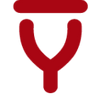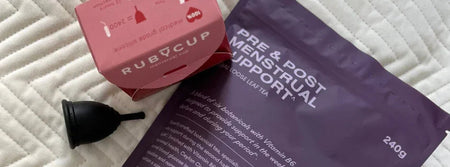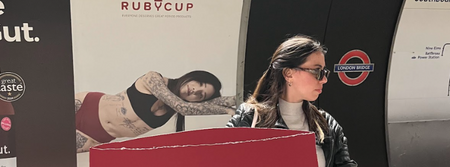So, how have the mood swings been coming along lately? What about the cramps and the bloating? Period symptoms are uncomfortable, sometimes even intolerable. And if you’ve ever wondered why these symptoms show up in a more extreme form one month, but the next it’s all so much easier to handle, then read on.
Well-known (and yes, annoying) period symptoms such as PMS, mood swings, bloating and cramps are all due to hormonal fluctuation – the reason our menstrual cycles occur in the first place. But if these hormones are out of balance, then the above-mentioned symptoms can get out of hand.
This post should help you understand how to use food as a resource to balance your hormones and support your body. Of course, for people who suffer from endometriosis or PCOS, simply trying to live a more healthy lifestyle will not help alleviate excruciating period pain.
We can’t say it enough: it’s important to accept that if your period or your cramps are a major disrupter of letting you lead a normal life (you miss work or school because of horrible cramps, your pain causes vomiting or fainting), please consult with a doctor, as there could be a more serious health issue causing the extreme period symptoms. And don’t rest until you find a doctor who takes your pain seriously.
Now back to hormone-balancing food: Enjoy this guide we put together to help you choose your meals so that they can support what your body needs during each menstrual phase.
What's best to eat BEFORE YOUR PERIOD (Cycle Day 20-30)
This is the phase after ovulation has occurred and lasts until the first day of your period. During this phase, your estrogen drops and your progesterone levels rise. For your mind and body, this means that you’ll likely to have less energy and you’ll feel the urge to slow down. You might even feel a bit foggy and sad.
Cravings are strong and you’ll feel hungrier more often during the day. That’s why it’s important to be prepared with healthy snacks that support your body in feeling better instead of increasing the cramps, cravings and bloating.
During this luteal phase, it’s actually more important to focus on what foods to avoid, rather than what to eat. Generally, reduce your intake of refined sugars, processed food as well as alcohol. A few drinks will likely not have an effect on your body, but they can alter your hormones, leading to increased moodiness.
- Eat healthy fats! Your body needs fats to make the hormones fluctuate smoothly. Avocados, nuts and olive oil are a good option for a healthy fat intake.
- Adding sesame seeds, which have a high content of zinc as well as adding sunflower seeds, with their high levels of vitamin E to your smoothies, salads or breakfast bowls will support your body in its progesterone production.
- Include fibre-rich fruits and nuts like almonds, apples, dates, peaches, and pears to combat bloating and bowel irritability. These are perfect to keep as healthy snacks throughout the day. Opt for these instead of a snickers bar.
- Grains like quinoa, buckwheat or brown rice can provide additional help with getting excess estrogen out of your body, which is what your body is trying to do naturally during this phase.
- When choosing side dishes for your main meals, go for roasted or baked vegetables like cauliflower, cabbage, parsnip, radishes, celery, and cucumber with onion and garlic.
- Stay hydrated! Avoid sodas and sugary drinks and focus on enough water intake. Add fresh mint and ginger to make a healthy lemonade and drink peppermint or chamomile tea at night to relax your body and mind.
- Keeping your iron levels up can help keep your mood and your energy levels up. It can also help with brain fog so make sure to include iron-rich food like nuts, beans, peas, red meat, and lentils in your diet. Reduce your intake of caffeine as this decreases absorption of iron. Here is a detailed post about anemia and periods, and how to keep your iron levels up during your period.
- Reduce salt intake (hence processes foods, as they’re normally very salty) as much as possible because sodium increases water retention which in turn makes you feel bloated.
Find recipes that will support your body during this menstrual phase here.
What’s best to eat DURING YOUR PERIOD (Cycle Day 1-7)
Especially during the first couple of days of your period you’ll feel withdrawn, your energy levels will be low and you’ll be tired. That’s why it’s important to focus on a diet that keeps your energy levels up.
- To beat tiredness replenish your iron and vitamin B12 intake by eating organic red meat, salmon, legumes, liver, beans, chickpeas, raisins, cheese, milk, almonds or fish.
- Even though cravings will still be strong, try to avoid eating junk and processed foods as they contain a lot of sodium and refined carbohydrates which increase bloating.
- You can replace unhealthy food cravings with healthier options like pieces of fruits, nibblling on nuts or almonds which are rich in omega-3. Try switching a candy bar for a piece of dark chocolate.
- Soft drinks are a hidden source of great amounts of refined sugar, which can increase your cramping. Try to replace the soda with lemon-water, a glass of freshly pressed juice, fruit or herbal tea or a smoothie.
- Try not to consume anything that is very cold. Drinks should at least be at room temperature.
- Have a cup of herbal tea instead of coffee to avoid increasing cramps due to the high levels of caffeine.
- Spice up your veggies or soup with some turmeric, cardamom, ginger, cilantro or cumin – these are all spices that will support anti-inflammation
Find great recipe inspiration for this phase here.
What to eat AFTER YOUR PERIOD (Cycle Day 7-18)
Starting already towards the end of your period, when your flow is lighter, you will want to focus on food that supports estrogen production. It’s the hormone responsible for boosting your mood and energy levels.
You’ll feel your absolute best during this phase, which leads up to ovulation, so this is a great time to start a new habit, focus on new workout routines and schedule social appointments.
- Adding a tablespoon of flaxseeds and pumpkin seeds to your salad, porridge or energy balls can naturally increase your estrogen levels.
- Make the most of the rise in energy levels, and get active. Support your muscles growth and body by making sure that your body gets enough proteins.
- You’re appetite will decrease during this phase, so focus on eating your meals regularly. It will be a lot easier to focus on healthy foods in smaller portions, so if there’s a new healthy recipe you want to try, this is the menstrual phase to do it.>
- It’s a great week to consume calcium-rich foods such as kale, spinach, collard greens or turnips.
- But there’s also a downside to all of the energy coming from the estrogen-peak: some might feel anxiety or stress. If that’s the case for you and you feel restless, try to meditate a little and add a ritual that includes drinking chamomile tea, taking a few moments for yourself and relaxing.
You can find a variety of creative, delicious recipes for this menstrual phase here.
The key to balancing hormones is a balanced lifestyle and diet
You’ll receive the best results through a holistic approach. Food is not the only factor that influences how you experience your period and its symptoms.
Working with your menstrual cycle to help make your periods easier is about taking an all-round approach to it: a balanced lifestyle with self-care, exercise and healthy diet are what will help you feel calm and good through every phase of your cycle.
Tip 1: Track your menstrual cycle.
Tracking your menstrual cycle will help you plan out your month so you know when and how to support your mind and body. For instance, make room for some quiet me-time and days to slow down before the first day of your period.
And make sure you have the grocery shopping for healthy, healing foods done before the period cramps, moodiness or cravings hit you.
Tip 2: If you don’t suffer from endometriosis, consider natural remedies before popping a painkiller.
Natural remedies for menstrual cramps, such as herbal teas or heating pads as well as can effectively help with period symptoms.
Also, reconsider the period product you use. Did you know that menstrual cups can shorten the days you have your period, make period cramps less agitating and help you feel more comfortable during your period?
Related post: Menstrual Cup Pain: Is It Normal & What Can You Do About It?
Tip 3: Consider doing some very light exercise for lower back pain
This is especially useful if you experience lower back pain during your period. Look into relaxing yoga poses to relieve menstrual cramps and relax the body.
Any type of exercise, no matter if it’s restorative yoga or cardio, will help you produce endorphins and help you feel better. The key is to listen to your body and decide what type of exercise will benefit you most.
Keep in mind that there is no golden rule to follow that will make all period symptoms disappear. And should you end up eating a pack of chocolate chip cookies instead of apples and almonds, that’s okay! The important thing is to focus on you and your needs, and if a chocolate chip cookie is what you need, then eat it.
Remember, this is about supporting your body. It will not make your periods completely painless but it will reduce some of the pains and discomfort. Love your body and your body will love you back!
Tip 4: Choosing the right period product for your body
The key to balancing hormones is a balanced lifestyle and diet—but it’s also about feeling supported and comfortable throughout your cycle. Choosing the right period products can make a subtle yet meaningful difference in your overall well-being. When you have period care that you trust, like our Ruby Cup and period underwear, you’re not only ensuring reliable leak protection but also reducing daily stress. This extra bit of comfort allows you to focus on nourishing your body with healthy foods, staying active, and maintaining that positive, balanced mindset every day.
FAQs
What are good foods to eat when you’re on your period?
You need energy-producing foods to eat when you're on your period such as:
- Organic red meat
- Liver
- Fish
- Nuts
- Legumes including lentils, peas, and chickpeas
- Beans and soybeans
- Cheese and milk
Also, spice up your meals with turmeric, cardamom, cilantro, cumin, or ginger for anti-inflammatory benefits.
What foods help with period cramps?
During your period, fluctuating hormones constrict your uterine muscles, which cause cramping. Some foods that help with period cramps are those that have a calming effect like herbal teas or camomile tea, and potassium-rich food like bananas and kiwis. Also, some menstrual cup users report experiencing less cramping, even though research has yet to prove this claim.
Why do I want to eat so much before my period?
If your hunger increases 10 days before your period, know that your hormones are fluctuating to prepare for a possible pregnancy. Your estrogen levels shift and your progesterone skyrockets, which means it's normal to feel more hungry during this time.
Is it OK to eat more before your period?
It's OK to eat more before your period, as long as you're eating healthy snacks and well-balanced meals. Before your period, avoid unhealthy fats, refined sugars, and processed food, which can alter your hormones. Substitute candy bars with nuts, seeds, and fresh fruit, and add avocados, olive oil, grains, and fish to your diet.
Should you give in to period cravings?
Though you shouldn't totally give in to eating junk or processed foods, which are rich in sodium, sugar, and refined carbohydrates, it's not healthy to completely deprive yourself either. Find a balance and eat healthily while treating yourself to a few cookies or slices of pizzas every once in a while.
Conclusion:
Eat your way to a healthier and more comfortable period
Now you know which foods and lifestyle choices can help you feel better during your period. Keep the right ingredients on hand and stock up on healthy snacks. And remember these key takeaways:
- Your menstrual cycle is a 21-40-day fluctuation of hormones.
- A well-balanced diet and lifestyle won't erase period pain, but they can help regulate your hormones, which will lessen your discomfort.
- Focus on iron-rich foods during your period.
- Eat calcium-rich and estrogen-balancing foods after your period.
- It's okay to overeat in the 10 days leading up to your period as long as you make (mostly) healthy choices.
- Include other pain-solving remedies like heating pads, exercise, relaxation techniques, and meditation.
- Use a menstrual cup to reduce the length of your period and help you feel more comfortable.
Once you meet the needs of your body and its fluctuating hormones with the right food, you'll find yourself mastering those cravings, indulging in self-care, and bouncing back with newfound energy. So start eating your way to a more comfortable period.
Written By Valentina Carrara
Valentina has been part of the Ruby Cup team for many years and is our go-to expert on menstrual cups. With plenty of knowledge and experience, she’s passionate about helping people understand how menstrual cups work (Ruby Cup is her favourite period product after all!) and why they’re a great option. If you have any questions or doubts, she’s always happy to help: Just drop her a message at hello@rubycup.com.










